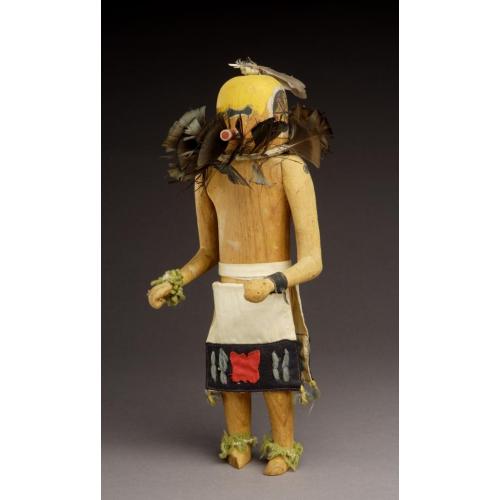
Photograph by Addison Doty. Copyright 2009 School for Advanced Research.
Salimobia Łuptsinna kokko we'ha | Yellow Salimobia kokko figure
Date: c. 1925-1940
Artist or Maker: Unknown
Dimensions:
28.6 cm (11 1/4 in.)
Medium: wood | paints | feathers | cotton | leather | yarn, synthetic | metal, iron
Credit Line: Gift of Peggy Pond Church.
Place Made:
Zuni Pueblo, McKinley County, New Mexico, Southwest, United States, North America
Object Number: SAR.1984-22-3
Not on view
Tribal Collection Review RemarksJim Enote and Octavius Seowtewa during collection review visit April 6 and 7, 2009 (Events Record “Collection Review: Zuni Tribe, Review 1”): This kokko is the yellow version of the Salimobia. It is related to IAF.C92 (yellow version) and IAF.C94 (blue version). All versions of the Salimobia are disciplinarians and keep order during ceremonies.
The variously colored Salimobia represent all the directional colors: yellow represents north, blue is west, red is south, and white is east. Black represents below or bottom, while above or top is represented by multi colors. These colors also represent the six kivas at Zuni.
ADDITIONAL INFORMATION: Jim Enote and Octavius Seowtewa during collection review visit April 10 and 11, 2014 (Events Record “Collection Review: Zuni Tribe, Review 13”): This kokko is carved from wood, possibly pine. The top of the head is painted yellow. The lower portion of the head is unpainted; it may have been painted after the feather ruff was attached, making it difficult to paint the entire surface. On top of the head, four unknown feathers are tied together with sewing thread onto a small stick that is affixed to the head. Though it isn’t known what these particular feathers are, on the dancer they would be macaw feathers, goose body feathers, and turkey feathers. There is a flower shape painted on either side of the head, in yellow, red, blue, black, and white. The eyes are represented by a wide black line that is rounded at either end, outline with light blue. The mouth beak is a tube shape that is painted red, with a black rectangle on either side, outlined in light blue; the black is meant to represent the mouth opening.
The figure wears a feather ruff below its face. Here the feathers are turkey feathers, but on a dancer they would be crow. The ruff is now missing many of its feathers. They are wrapped with white cotton string onto a cotton string base.
The torso and arms show remnants of commercial yellow paint, though most of it is now gone. The arms are articulated at the shoulders and attached to the body with a nail through each shoulder. The left arm has a black leather bow guard at the wrist. The right wrist has green yarns tied onto it, representing evergreens.
The figure wears white fabric breech cloth with a dark blue panel sewn to the lower portion of both the front and the back. There are red and blue applique decorations on the blue panels, with blue and yellow yarn tassels at the corners. The strip of white cloth at the waist represents the blue belt that would be worn by this dancer. There is also a white cotton string tied around the waist, which was for hanging the figure on a wall.
The green yarns tied at the ankles are meant to represent evergreens.
There are several pieces missing or are different from the kokko’s outfit as compared to what the dancer would wear. It’s missing a short turquoise necklace that would be worn in front and a bandolier strap and pouch. It should be holding yucca whips in both of its hands. (The dancer uses several blades of wrapped tightly together, forming a whip four or five feet long.) It should be holding a deer scapulae in its left hand. The dancers used to go barefooted, as this figure does, but now they wear moccasins.
In Collection(s)
The Indian Arts Research Center, in collaboration with Native American community scholars, strives to present accurate collections records. Records may be updated as new information becomes available and is reviewed with the Native American community having cultural affinity to particular items. Please write to iarc@sarsf.org if you have questions or concerns related to the documentation.
